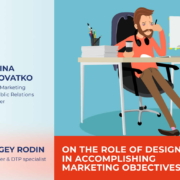On the Role of Design in Accomplishing Marketing Objectives
With nearly 10 years of experience in the marketing, public relations, and advertising fields, I have come to understand that harmony of form and content is the secret to the success of any marketing communication. In the case of marketing collateral such as printed and promotional items, including brochures, booklets, leaflets, etc., the harmonious interplay of text and design produces exceptional materials that effectively aid the company in accomplishing its various objectives.
What, in my opinion, constitutes an effective and successful marketing piece? First, it should align with the company‘s corporate style, effectively showcasing its brand and contributing to its recognition. Second, it should be conspicuous, appealing, and steer clear of evoking any negative emotions or associations. It should appeal to the audience both aesthetically and at various levels of comprehension. Third, it should be appropriate: not too flashy, but also not dull or faceless. Fourth, it should be relevant and in line with current trends in marketing communications and design. However, it should avoid blending in with other similar advertising and marketing messages, while preserving its own unique style. Balance and harmony are crucial in all aspects. Finally, and most importantly, it should work toward accomplishing the company’s objectives.
The designer is the most important business partner for marketers, copywriters, and advertising or public relations professionals. If there is mutual understanding between them, it’s fantastic. The key to success is the ability to actively listen and properly formulate the terms of reference.
What do I believe is necessary for properly formulating the designer’s terms of reference to achieve the desired outcome?
- Speak the same language: avoid using unclear wording, highly specialized terms, vague concepts, and other things like that.
- Provide examples – references, various design solutions you found appealing or unappealing that are relevant to the stated objective, and so on.
- Provide enough information. Keep and mind the significance of balance: both a lack and an excess of information are equally flawed.
- Communicate constantly: analyze drafts, respond to inquiries promptly, and provide feedback.
I asked Sergey Rodin, a designer from the marketing department, to answer some questions about the design of marketing collateral, the development of corporate style, and related topics. Sergey has been working in the design industry for roughly 20 years. Over this impressive period, he has successfully implemented numerous projects and is now ready to share his vision.
What is it like to design great marketing collateral?
“When it comes to design, it is important to distill large amounts of information so that the client can understand the purpose of the booklet at a glance. At exhibitions, various companies distribute a lot of their promotional materials, and once event concludes, the visitor’s briefcase is filled to the brim with all kinds of brochures, booklets, leaflets, and other collateral. The first thing such a visitor will notice is the professional design approach of promotional materials, and it is these materials that will be viewed first. The designer’s task is to attract initial attention to the materials and to encourage the target audience to familiarize themselves with the content. Exhibitions are always preceded by meticulous preparation. Everything is important, from designing a business card to setting up a booth. All of this should be executed in a uniform style. Taking such matters lightly would be unprofessional.”
What is taken into consideration when creating a corporate style?
“When developing a corporate style, it is important to understand the company it’s intended for, its philosophy and traditions. When I undertook the task of designing a new corporate style for Janus Worldwide, I would spend some time brainstorming, listening to colleagues, making adjustments, and then I would get to work. And after about a year of such experiments, our design for the future corporate style began to take shape. During that time, I updated fonts to modern ones, removed outdated layout elements, picked out vibrant and appealing gradients, and more. Now I would say that our design is actually on trend.”
How often should a corporate style be updated?
“I consider it essential to update a corporate style when it starts to become outdated. By the time I started at Janus Worldwide, its corporate style had already been established. My predecessor had made a significant effort in this regard. There are many companies that do not pay enough attention to their corporate style, and, as a result, their marketing collateral ends up looking unappealing and fails to stand out among the well-crafted materials. Our company had no such problems, but over time, I began to realize that it was time to change the corporate style to bring it in line with modern design trends. I have accomplished this task: we have rejected dark colors in favor of brighter ones, provided the necessary dynamism to permanent layout elements, and so on.”
What is the best way to set the task for the designer in order to achieve the desired outcome? What should you consider when formulating the terms of reference?
“The success of a design primarily depends on the properly formulated terms of reference. Entering the workflow is easy when you have a clear understanding of the customer’s needs and you don’t have to spend a lot of time clarifying details. And when I receive a file with all the text already distributed across pages, it speeds up my work. I can immediately see which pages will have a significant amount of text and visualize the future design. ? Sometimes, in the process of designing a layout, you may realize that there is too much text. I really appreciate it when the customer makes concessions and edits the text slightly to ensure the finished booklet look flawless.
I am happy to share a few helpful tips for customers on the development of printed marketing materials.
- If you have a lot of text in your file, try shortening it a bit, but maintain the core idea.
- Work on your headlines: they should be concise.
- Highlighting a few key sentences will help with the layout.
- Organize the text across pages, i.e., indicate what should be on the first page, second page, and so forth.
- Trust your designer!” ?
We hope this article will encourage you to take a fresh look at your marketing collateral, give you some new ideas, and inspire you to implement changes!







